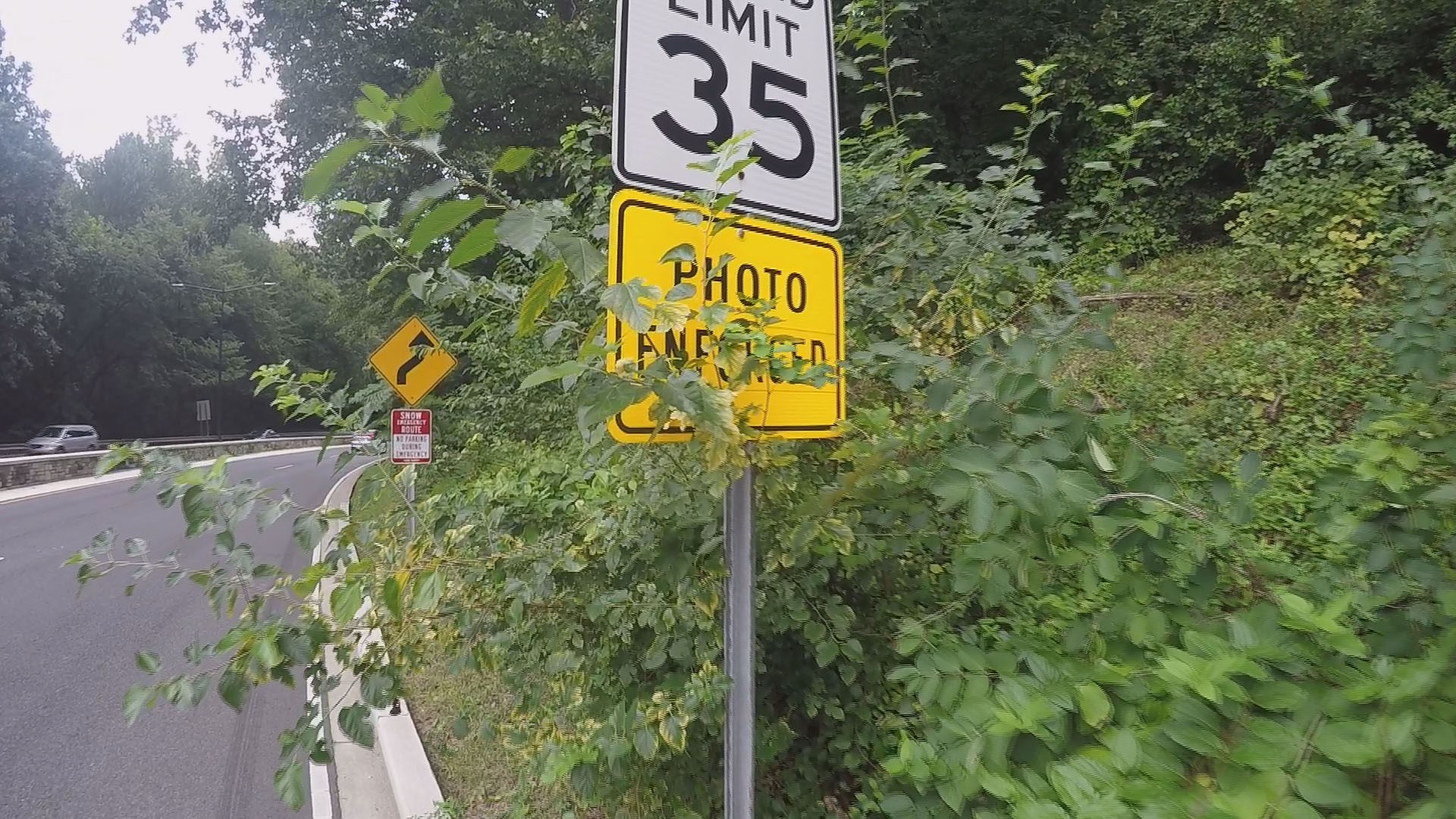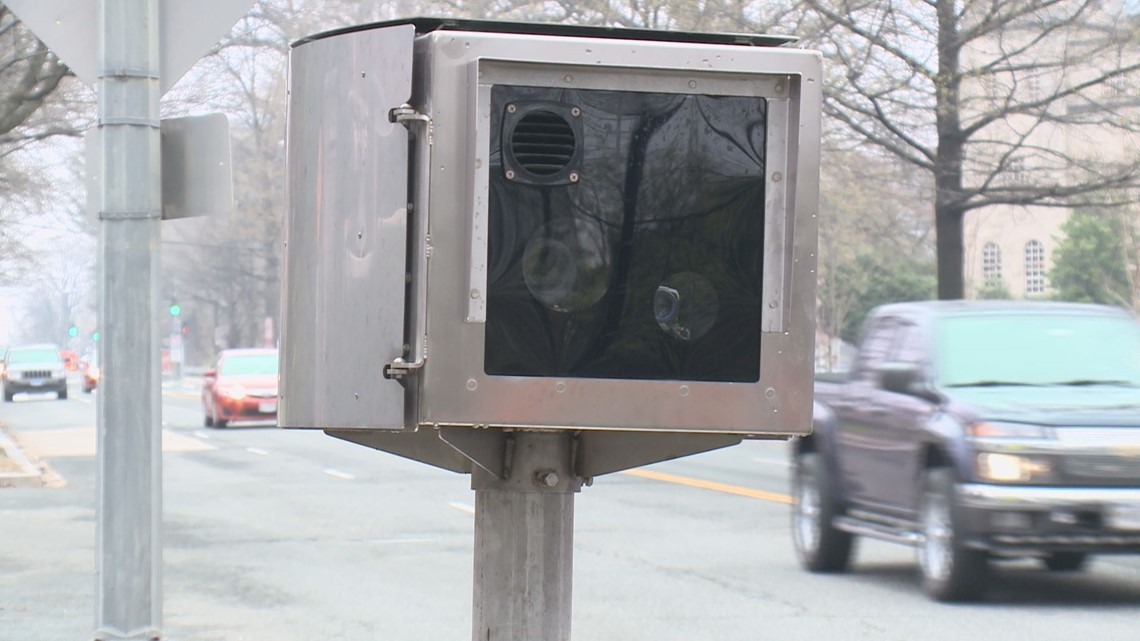Confusion, contradictions plague DC speed camera warning signs
New technology has made speeding cameras extremely affective. In DC, each camera has to have signs warning you they're coming. But that's not the case for some.

Lamar Trowers saw the flash right away as he drove eastbound in the 2200 block of K Street downtown.
One of DC’s automated traffic enforcement cameras had tagged him for going 36 mph in a 25 mph zone. It was a $100 fine that Trowers never saw coming.
“Sometimes you can’t see the signs they’re obscured,” Trowers said of the yellow “photo enforcement” warning signs that are supposed to alert drivers a speed camera is nearby.
The WUSA 9 Special Assignment Unit discovered that it is an issue across the city. The only issue when it comes to how the District sets up its 87 speed cameras which brought in more than $99 million in fines in 2016.
The camera on K Street that caught Trowers brought in $11.8 million. Trowers is not the only one with questions about whether those speed cameras are there to save lives or just line the city’s pockets.
“People should comply with the law, but we shouldn't set up a situation where people feel like they are being tricked,” said DC Councilmember Mary Cheh.
The WUSA 9 Special Assignment Unit spent days driving around DC to find out why people would feel that way. The investigative team inspected bigger, fixed location cameras and the smaller mobile cameras, which can be moved from place to place.
The first thing reporters noticed was brush blocking those bright yellow photo enforced signs that are supposed to warn drivers there’s a speed camera ahead.
The Special Assignment Unit found at least five speed cameras like that. From a totally covered sign on Military Road to partially obstructed ones on Good Hope Road, Hillcrest Drive, 19th Street and 14th Street.
But there was more.
A speed camera sign on South Dakota Avenue was facing the wrong direction. Away from the street. Meaning the only driver it could warn would be coming out of the driveway at that location, when speed would not be an issue.


WUSA 9 also found a speed camera on Blagden Ave in Northwest blocks from the location that’s listed on the DC police website. A list the police department publishes to be “transparent.”
Meanwhile, the only warning sign for the speed camera on I-295, sits right next to it. No time to slow down before getting ticketed there.
Then there’s the speed camera on Riggs Road. With a warning sign, behind the speed camera rather than in front of it. Once again, failing to properly warn drivers.
There also seemed to be no consistent guidelines with how many warning signs the city displays for each speed camera.
The Special Assignment Unit counted five warning signs for the speed camera on C Street near RFK.
Many others, had just a single warning sign. The sign on Eastern Ave, was more than a thousand feet from the camera itself.
In the Fall of 2017, DC Councilmember Mary Cheh had questions too, so she called on the city for an internal review. She sent a letter to the head of the District Department of Transportation asking it to “closely review the roads and intersections where photo enforcement exists to ensure that…drivers are given proper notice of the presence of a camera.”
Cheh said she’s worried about locations where warning signs are blocked, places where the speed limit drops suddenly and streets where speed cameras are set up on a downhill slope like that spot on K Street where Trowers got tagged.
“If people think that we’re trapping them...that we’re tricking them, it loses confidence in what we’re doing,” Cheh said.
In response to questions from the WUSA 9 Special Assignment Unit, DC police said there were no specific rules and regulations for how warning signs for automated speed cameras are displayed, only some internal guidelines.
In an email, DDOT seemed to contradict that statement, writing there is a set standard the District is supposed to follow, laid out by the Federal Highway Administration’s Manual on Uniform Traffic Control Devices.
But that standard basically said the warning signs can be put anywhere around the city. Technically warning signs are not required at the speed camera locations themselves.

AAA-Mid Atlantic Spokesman John Townsend, a critic of the current system, was not surprised.
“When it comes to the automatic traffic enforcement program, in the District of Columbia, it’s the wild wild west,” Townsend said.
Trowers wants more DC residents to take speed camera complaints to their councilmembers.
“They’re milking their residents dry,” Trowers said.
Demanding change to a system he thinks is less about safety, than dollars and cents.
In its response to Councilmember Cheh, DDOT said it would take a look at all speed camera warning signs to make sure they are adequate and install additional sings where needed.
DDOT said it would also study those speed camera locations that rake in most revenue, although any design adjustments would take time.
(These are the locations of speed cameras as of Nov. 2017)
